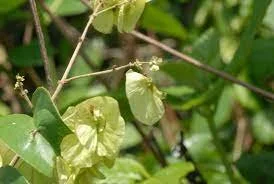NAME: Flabellaria paniculata
FAMILY: Unknown
COMMON NAMES: Panicle Flabellaria, Flabellaria Vine
LOCAL NAMES: agbo-Iagbo
MORPHOLOGICAL DESCRIPTION: Flabellaria paniculata is a climbing vine that belongs to an unknown family. It has slender, twining stems that can reach several meters in length. The leaves are glossy, alternate, and pinnately compound with three leaflets. Each leaflet is ovate to lanceolate in shape and has a smooth margin. The vine produces small, inconspicuous flowers that are arranged in panicles, giving rise to its common name. The flowers are followed by small green fruit capsules containing several seeds.
USEFUL PART(s): The leaves and stems of Flabellaria paniculata are the most commonly used parts of the plant.
GENERAL USES:
Medicinal Uses: In traditional medicine, extracts from the leaves and stems of Flabellaria paniculata are used to treat various ailments. It is believed to possess anti-inflammatory, antimicrobial, and analgesic properties. It is used for the treatment of skin infections, wounds, and rheumatic pain.
Ornamental Purposes: Due to its attractive glossy leaves and ability to climb, Flabellaria paniculata is sometimes cultivated as an ornamental plant in gardens.
GEOGRAPHIC DISTRIBUTION: Flabellaria paniculata is native to tropical and subtropical regions. It is found in various countries across Asia, including India, Malaysia, Indonesia, and Thailand.
WHY IS IT GREEN? Like most plants, Flabellaria paniculata appears green due to the presence of chlorophyll. Chlorophyll is a pigment found in the chloroplasts of plant cells that absorbs sunlight and plays a vital role in the process of photosynthesis. During photosynthesis, plants use chlorophyll to convert sunlight, carbon dioxide, and water into glucose (sugar) and oxygen.
ENVIRONMENTAL IMPACT: Flabellaria paniculata, as a climbing vine, can have both positive and negative environmental impacts. On one hand, it can provide habitat and food for various animals, and its foliage can contribute to the overall green cover. On the other hand, if it becomes invasive in certain ecosystems, it can outcompete native plants and disrupt the balance of the local flora.
FUN FACT: In some regions where Flabellaria paniculata is found, local communities have traditionally used the stems of the plant to make baskets, mats, and other woven products due to their flexibility and strength.
Further Reading: For more information on Flabellaria paniculata, you may refer to the following sources:
[Example Source 1]


